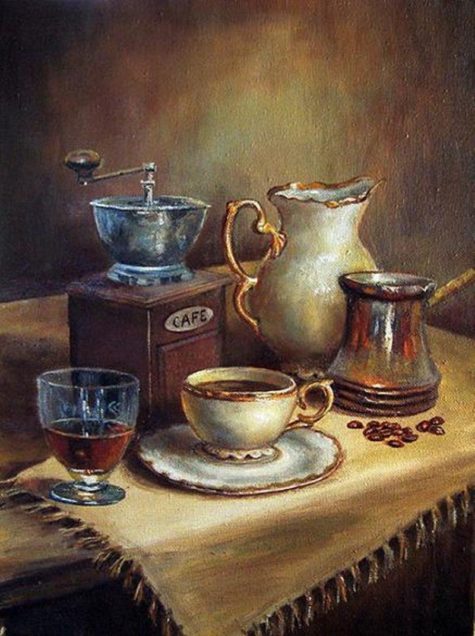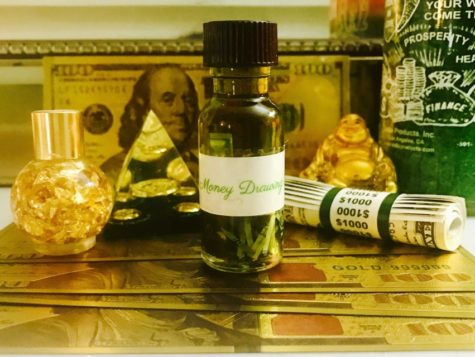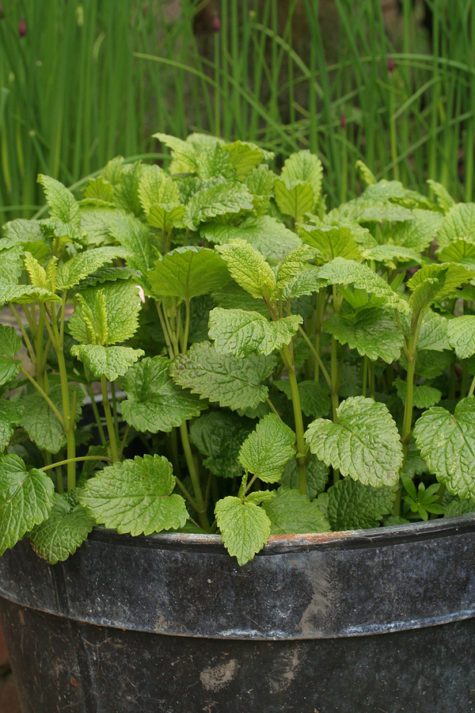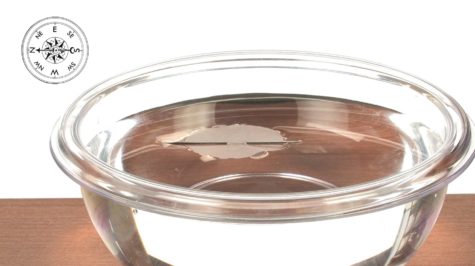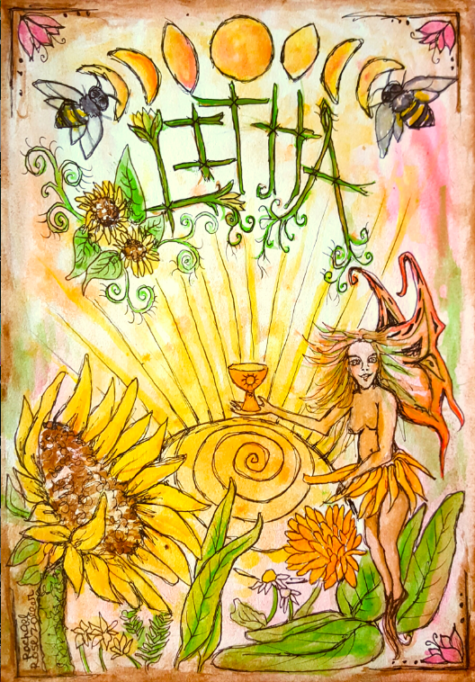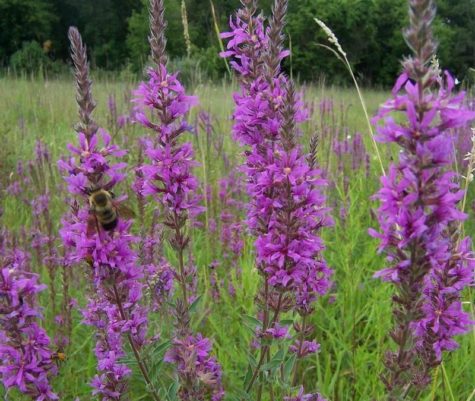Yearly Archives: 2017
The Poplar or Aspen is the sacred Tree of the Fall Equinox – (Aprox. September 22).
There is a bit of confusion about poplar, aspen, and cottonwood trees. The tree referred to here is the genus “populus” which includes true poplars, as well as related trees such as cottonwood and aspen).
Here’s a quick list:
- Balsam Poplar (Populus balsamifera)
- Eastern Cottonwood (Populus deltoides)
- Bigtooth Aspen (Populus grandidentata)
- Black Poplar (Populus nigra)
- European Aspen (Populus tremula)
- Quaking Aspen (Populus tremuloides)
- Black Cottonwood (Populus trichocarpa)
As far as I could discover, the Aspen and Poplar tree magickal lore overlap, and can be used interchangeably, unless otherwise indicated. The lore does not refer to the Yellow Poplar (Liriodendron tulipifera), or Balm of Gilead (Populus candicans) which have different attributes and magickal qualities
- Celtic name: Eadha (pronounced: “Eh’ uh”).
- Folk or Common names: All Poplar – Popple, Alamo, Aspen; Trembling Poplar – American Aspen, White Poplar, or Quaking Aspen; Balm of Gilead – bombagillia.
Magickal Usage:
- Ruler: Saturn
- Type: Plant
- Magickal form: Buds
Carry poplar buds with you when seeking employment. Crush and add them to traditional money incense when you work on commission and need to attract more funds. The poplar buds may also be added to divination blends and make a great ingredient for psychics wishing to attract more business, as well as improving their powers.
The Poplar’s ability to resist and to shield, its association with speech, language and the Winds indicates an ability to endure and conquer. The Poplar is known as the “Tree that Transcends Fear”. Poplars symbolize the magick of joy, the aging of the year, resurrection and hope – and are connected to the Otherworld. Poplar can be used in magick done for success, passage and transformation, Hope, rebirth, divinations, shielding, endurance, agility in speech and language, protection, and love – and as an aid in astral projection.
Poplar can be used in protection charms of all kinds. Poplar is a good wood to burn in balefires and ritual fires since it offers protection. Shields can be made of Poplar since the wood is thought to offer protection from injury or death. Carrying Poplar helps to overcome the urge to give way under the burden of worldly pressures, and aids in determination. Poplar buds can also be carried to attract money and can be burned as an incense to create financial security.
Siberian reindeer-hunting cultures carved small goddess statues of Poplar (Aspen) wood. Groats and fat were then offered to the figures with this prayer:
“Help us to keep healthy!
Help us to hunt much game!”
Poplar buds are also sometimes added to flying ointments and was also used in astral travel. A medieval recipe for a flying ointment called for Cinquefoil, Poplar leaves, soot and bat’s blood obtained at the wake of the new moon.
The trembling leaves of the Poplar tree can be ‘read’ to divine messages from the God and Goddess, and also from spirits that drift into woods. The Poplar is the sacred World Tree of the Lakota nation. For the sun dance ceremony, a Poplar is carefully cut and lowered, then is re-erected in the center of the dance circle. While being carried the Poplar must never touch the ground. Green branches, a buffalo skull and eagle feathers were used to decorate the Poplar for this ceremony.
Aspen Lore:
A country name for the aspen is the Shivver-tree, a name which in some districts is also given to the poplar. The leaves of both trees tremble at the slightest stirring of air, so that they seem to move without ceasing when all around is still. Because of this, both trees were formerly credited with the power to cure agues and fevers.
A very old magical tradition held that ailments could most efficaciously be treated by something that resembled their effects; and since ague causes the patient to shake and tremble, he was likely to be healed by the shaking tree.
In his Folk-Lore of the Northern Counties, William Henderson relates the story of a Lincolnshire girl who was thus cured of ague. She was advised to pin a lock of her hair to an aspen, saying as she did so:
“Aspen tree, aspen tree,
I prithee to shake and shiver
Instead of me.”
As was usual in such charms, her journey home had then to be made in complete silence, otherwise the magic would not work. She followed the advice given, and many years later, when she was an old woman, she told Henderson’s informant that she had never been troubled with ague again.
Another method was to bore a small hole in the tree trunk, insert the patient’s nail parings, and close the hole securely. As the bark grew once more over the opening, so the disease would disappear.
Two widespread legends are told to account for the aspen’s trembling. One is that it was condemned to shiver thus for evermore because it was the only tree that would not bow down to Our Lord when He passed through the forest. The other is that it shudders perpetually with horror because its wood was used to make the Cross on Calvary.
Poplar Lore:
 The poplar shares with the aspen the country name of Shivver-tree because like those of the latter, its leaves tremble. It also shares, and for the same reason, the aspen’s power to cure agues and fevers. R.M. Heanley records a Lincolnshire charm in which the patient cut off a lock of his hair and wrapped round a black poplar branch, saying as he did so:
The poplar shares with the aspen the country name of Shivver-tree because like those of the latter, its leaves tremble. It also shares, and for the same reason, the aspen’s power to cure agues and fevers. R.M. Heanley records a Lincolnshire charm in which the patient cut off a lock of his hair and wrapped round a black poplar branch, saying as he did so:
When Christ our Lord was on the Cross,
Then didst thou sadly shivver and toss.
My aches and pains thou now must take,
Instead of me I bid thee shake.
He then had to go straight home, speaking to no one on the way, after which he would be free from ague forever. Heanley adds that some people considered it necessary to fast for twelve hours before attempting this charm.
The constant shaking of the poplar is often accounted for by the legend that its wood was used in the construction of the Cross. Medieval Legends of Christ (1934), mentions two explanatory legends. One is that it was under a poplar that Our Lord prayed during His agony in the Garden of Gethsemane, and that the tree has trembled in sympathy ever since. The other is that it was cursed because, alone among the trees, it refused to mourn at the Crucifixion, saying that Christ died for sinners, “but I am innocent, and His suffering is no concern of mine.”
Poplar leaves were supposed to be one of the ingredients of the witches’ flying ointments.
Magical History and Associations:
In Gaelic tongue the tree was called Peble and Pophuil in the celtic way. Poplar is generally a plant of Jupiter, Saturn and the Sun and is associated with the element of water. Its color is rufous (red) and the bird associated with Poplar is the Whistling Swan. The stones associated with Poplar are Amber, Citrine Quartz, Sapphire and Swan Fluorite. The Anglo-Saxon rune poem seems to refer to the Poplar as being associated with the rune “berkano”.
Heracles wore a crown of Poplar leaves in triumph after killing the giant Cacus (the evil one) and retrieving Cerberus from Hades. The upper surface of the Poplar leaves was thus darkened from Hades’ smokey fumes. Poplar trees are sacred to the Mesopotamian goddess Ua-Ildak. The Grass King of Grossvargula, who was seen as having fertilizing powers, went on horseback wearing a pyramid of Poplar branches and a crown. He led a procession of young men about the town and was then stripped of his branches beneath the Silver Lindens of Sommerberg.
Poplar (Aspen) is said to be the tree of the Autumn Equinox and of old age, and is known as the shield makers’ tree. The Black Poplar was a funeral tree sacred to Hecate as death goddess, to Egeria, and to Mother Earth. Plato makes a reference to the use of Black Poplar and Silver Fir as an aid in divination. The Silver Fir standing for hope assured and the Black Poplar for loss of hope. The Grove of Persephone in the Far West contained Black Poplars and old Willows.
In ancient Ireland, the coffin makers measuring rod was made of Aspen, apparently to remind the dead that this was not the end. In Christian lore, the quaking Poplar (Aspen) was used to construct Christ’s cross, and the leaves of the tree quiver when they remember this fact.
Herbal usage:
Poplar can be used as a tonic, chiefly used in treating fevers. The infusion has been found helpful in treating chronic diarrhea. The sap collected from the buds can be used to make a healing ointment and can be used as an external application in bruises, swellings, and some skin diseases. Teas can be made from the Poplar buds and are useful in helping treat arthritis and rheumatism.
Source: Dutchie.org
- Provides peace of mind and grounding.
- Helps to dispel nightmares, negative thoughts, and overcome blockages and unhealthy emotions. It’s great for protection and getting rid of all kinds of nasties.
- Coffee is a stimulant and can be used to give spells, potions and charms an extra kick, or speed things up.
- Coffee grounds can be used in divination and read like tea leaves.
- It is considered excellent for curse breaking.
- It can be used as an offering to deities, entities, and ancestors.
- Some sources suggest it can be used for compulsion, and encouraging others to be more persuasive towards you. This is most effective when the coffee is served to the target.
Bubbles appearing in a cup of coffee are a sign of good luck, especially if they are caught with a spoon and eaten. This is hard to do, as the bubbles disappear quickly. However, anyone who achieves it will receive a surprise windfall.
The movement of any bubbles on the surface of a cup of coffee can be interpreted. It is a sign of money ahead if they move toward the drinker. Unfortunately, it means the opposite if they float away from the drinker.
It is bad luck to stir coffee with a fork.
Muslims believe the archangel Gabriel invented coffee. One day when Mohammed was extremely tired, Gabriel brought him a cup of coffee. This invigorated Mohammed so much that after drinking it he defeated forty horsemen and satisfied forty women.
Borrowed from: The Prosperity Project and The Encyclopedia of Superstitions
What follows is a list of the most often recommended essential oils for prosperity, along with some simple ideas for how to use them.
- Cinnamon (Cinnamomum Zeylanicum)
It has a long tradition of use, having been produced in Sri Lanka for more than 2,000 years. Historically cinnamon oil was used in the Middle East and Orient for combating viruses and infectious disease. Cinnamon Oil dates back to the Egyptians! The essential oil promotes a healthy immune response, and may help maintain a healthy lifestyle regimen. Brings feelings of joy.
Caution: Cinnamon oil is suitable for skin application in weak dilutions of less than 1%.
Note: Cinnamon oil is made two ways, one with the bark and the other with the leaves. For the purposes of prosperity, I don’t think it matters which you choose. If you are using it medicinally, it might be good to do some research.
Cinnamon is said to attract wealth by transforming our core beliefs of limitation into abundance. It will release anger, frustration and abuse that we have buried that deal with our dependence and addictions.
It is good for those of us who really want to look at and change their belief systems or their old patterns. This will help those who need to release memories of physical abuse (including slavery) whether it is this life or a past life.
- Myrrh (Commiphora myrrha)
Myrrh is a very powerful antioxidant making it supportive for healthy skin. It opens our mind to receiving gifts. The benefits of Myrrh include the spiritual and emotional as well. Myrrh is very spiritual oil and has been used in religious ceremonies and rituals for over 5000 years!
Traditionally myrrh oil has been used for enhancing spiritual and emotional well-being. It is an excellent aid to the healthy functioning of the limbic (emotional center) of your brain.
In the Christian tradition, Myrrh was given to Baby Jesus along with Frankincense and Gold. So, Myrrh and Frankincense were considered luxury items used by the wealthy and highly regarded next to gold.
Myrrh releases fears, difficult experiences as it relates to us or the world. It asks us to be more accepting, trusting and non-judgmental of ourselves.
When we can love and trust ourselves more, than we don’t attract situations that are as painful and we learn to integrate our physical with our spiritual being.
Because this oil opens the heart chakra and is uplifting to the mind, it can relieve stress and relax the body. Place on the heart to release this patterning and embrace relationships (self and others).
- Spikenard (Nardostachys Jatamansi)
A valued oil since ancient times spikenard has often been used in anointing rituals and religious ceremonies. It was the foot balm Mary Magdalene used to anoint her master’s feet in the New Testament of the Bible. For centuries, Spikenard has been used traditionally in Ayurvedic health practices native to India, and was historically used to anoint those of high honor.
One of the greatest benefits of Spikenard oil is its uplifting aroma that can help promote feelings of relaxation and calmness. Throughout history, Spikenard has commonly been used to manage and uplift mood, or to help promote relaxation. Today, Spikenard oil can be helpful for promoting calm, relaxing, or uplifting feelings when used topically or aromatically.
Not only is Spikenard oil known for its uplifting properties, but it is also a very grounding oil. The grounding properties of Spikenard essential oil make it a popular choice for aromatherapy and meditation. The woody, musty scent of Spikenard oil makes it a useful oil for aromatherapy and massage, while the grounding properties make it useful for promoting relaxation during meditation.
Spikenard oil can be applied topically to help promote calm or relaxing feelings. When you want to experience the calming benefits of Spikenard essential oil, apply one or two drops to the temples or back of the neck. Before applying Spikenard to the skin, consider diluting the oil with Coconut Oil to help minimize skin sensitivity.
- Sandalwood (Santalum Album)
A known aphrodisiac sandalwood oil is used extensively in Indian temples, as well as in churches around the world in religious ceremonies for worshiping the divine.
Used for centuries in Hindu, Buddhist, and ancient Egyptian ceremonies, burning sandalwood was thought to relieve depression and restlessness, promoting spirituality and inner peace. The fragrance is still used today in funeral rites to instill comfort and acceptance among mourners.
Paradoxically, sandalwood oil has also been shown to be both soothing and stimulating. When used topically, sandalwood oil was found to have relaxant properties without causing drowsiness, according to research published in 2004.
- Ginger (Zingiber Officinale)
In the first century AD, ginger was exported to Europe via India as part of the lucrative spice trade. Ginger was used extensively by the Romans.
Ginger is one of those herbs that has a long history in East Asia for bringing luck. The oil can be rubbed on money, helping you to remember not to “burn” through it – the heat of the oil is thought to counter the ‘fire’ you feel to spend!
Supportive of the digestive system, ginger is commonly used to soothe, comfort, and balance digestive discomfort. Emotionally it gives us courage.
Did you know that the West African women in Senegal weave belts of ginger to arouse sexual interest in their partners? Wow, that’s interesting!
Its spicy and sweet aroma makes one physically energized.
The benefits of ginger are not lacking in the spiritual side of things either.
As a matter of fact, Ginger addresses “lack” and therefore would assist those who need self-confidence and motivation to put plans and ideas into the physical realm. In other words, it allows us to “digest” parts of ourselves that need to be changed so we can better serve ourselves.
We know that ginger has an aphrodisiac effect on the body as well. Therefore, it opens the root and sacral chakras and will release suppressed sexual energy.
- Spruce (Picea mariana)
Spruce oil is physically grounding and relaxing. Has a sweet and earthy scent that is fresh and fruity. It is also said to release blocks to prosperity and wealth.
Native Americans used Spruce for its purifying and cleansing effect as well as for medicinal, spiritual and practical reasons. They used it for protection and capturing the universal energy here on earth the earth plane.
Spruce essential oil will ground and balance the body and release emotional blocks.
By the way, any of the oils that are from trees (Western Red Cedar, Palo Santo, Cedarwood, Frankincense, etc) will provide stabilization, grounding and security to our being, physically and emotionally.
- Cedarwood (Cedrus atlantica)
This intense, deeply sensual scent goes hand in hand with attracting power to your life. It’s also a scent commonly associated with beauty and prosperity, likely due to the sensual and grounding notes in the aroma.
It’s also often considered a protective essential oil, so not only could it attract prosperity to you, but it can also protect you from misery and misfortune.
Wear just one drop in a diffuser around your neck, or anoint a single drop over your heart to help bring out your inner beauty and strength. You don’t want to overdo this powerful scent, and a single drop is plenty to help you attract the prosperity you desire into your life!
If you are feeling in any way tense, stressed or depressed try inhaling cedarwood essential oil from the bottle or put a few drops on a handkerchief and breathe it in whenever you feel the need. You can also get all the benefits of its aromatic properties by diffusing cedarwood essential oil in a diffuser machine.
- Patchouli (Pogostemon Cablin)
This oil has been used to relax the mind and clarify thoughts for hundreds of years. Originating in southeast Asia patchouli has been used for thousands of years. The early European traders were reported to have exchanged one pound of patchouli for a pound of gold.
An earthy, intense oil that helps inspire happiness and optimism. It can help sharpen your wits. It reestablishes mental and emotional equilibrium and energizes the mind.
Patchouli Essential Oil is primarily used to align the heart chakra with the root and sacral chakras. It does this by releasing obsessions, insecurities and jealousies and enhancing our desire to live a fuller life.
It also grounds the body and asks us to stay in the present moment rather than stressing about things that are beyond our control.
Much like bergamot, patchouli essential oil often has connections with attracting money. Supposedly, it’s also an oil that has the ability to attract love into your life… so you may want to mix up a little into your own custom perfume blend before you go out for the night!
- Bergamot ( Citrus bergamia )
Bergamot’s effects are uplifting as well as relaxing. It opens up the heart chakra, and allows you to release your need to be in complete control of a given situation. Does it really bring you success and money? Maybe – although it’s probably more related to your own confidence and uplifted state of mind!
Diffuse bergamot oil to bring yourself success and money – or add a drop to your wallet, while envisioning your wallet filling up with cash!
Another way is to anoint yourself with it to bring success and money – meaning add a drop to your finger tip, then rub it on each wrist, and a little bit on your forehead.
- Sweet Orange (Citrus Sinensis)
Orange Essential Oil is rich in the powerful antioxidant d-limonene and aids in maintaining normal cellular regeneration. Also has calming effects and may be used for feelings of peace.
Mentioned in Chinese literature in 314 BC oranges make a wonderful nerve tonic. A happy oil with the scent of sweet oranges promotes relief of physical and emotional tension.
Caution: May cause photosensitivity. Avoid exposure to direct sunlight after skin application for up to 12 hours.
Its fresh and citrus aroma is very uplifting to the body and mind.
Orange Essential Oil uses include the spiritual and emotional realm as well. Orange releases self judgment, obsessions and fears so the emotional body can be restored and balanced. When we release these negative and highly charged emotions we can see clearly again and make better choices for our life.
It will lend support by uplifting and promoting a positive attitude while calming our spirit. This oil will help those who tend to overwork, strive for perfection, but get aggravated quickly by intolerances or mistakes.
- Galbanum (Ferula Galbaniflua)
Traditionally galbanum has been used for making incense and is mentioned in the Book of Exodus 30:34 for this purpose. The ancient Egyptians highly favored galbanum as a holy plant aromatic and the reputed “green” incense of ancient Egypt is thought to be galbanum.
This magickal essential oil empowers positive sacrifice in the sense of giving up in order to change for the better. It also assists in one’s exploration of the self, but what it reveals can be shocking. This scent has traditionally been used for acquiring magickal skills such as divination, contact with angels, and communicating with the dead.
- Frankincense (Boswellia Frereana)
One of the ‘Holy’ oils from ancient times when it was considered more valuable than gold, frankincense oil has a powerful and enticing sweet, balsamic and warm wood aroma that sweetly sparkles with freshness and a hint of spice and incense-like overtones. It is uplifting and centering.
This precious oil was found in King Tut’s tomb in Ancient Egypt.
Frankincense Essential Oil helps to uplift mood and brings feelings of relaxation. It may help smooth the appearance of healthy-looking skin, and is useful in combination with massage after exercise.
Frankincense oil has been used to awaken our spiritual awareness and connect with spirit for 5000 years or more. It will help us release parts of our ego which hold us back from connecting with our soul, as well as feelings of unworthiness and insecurity.
Once we are able to connect with our spiritual side, we can embrace our true purpose in the world and become more spiritually driven rather than ego driven.
Use Frankincense during meditation to connect with spirit and stay centered in meditation.
- Clove (Eugenia Caryophyllata)
Clove bud oil shares similar antiseptic and anti-microbial qualities as cinnamon leaf oil. Use clove oil to help restore the loss of your inner drive and motivation. Its hot and spicy aroma brings clarity!
Caution: Clove oil is known to irritate the skin and mucous membranes and generally not for use in skin except in extremely weak dilutions of less than 1%. Please respect the power inherent in clove oil and use with extreme care.
Promotes a healthy immune response, and may support overall wellness. An important ingredient in Young Living’s Thieves blend, its principal constituent is eugenol.
Clove oil uses includes the spiritual realm as well. Clove is said to provide insight into our emotional discomfort.
How many times have something has happened only to find out later there actually was a hidden meaning behind it?
For me, all the time! But it was about eight years ago that I realized that every time I really just didn’t want to go to work that day, I would manifest something that would self sabotage!
We all have days like that, but that was how I learned to “take a day off”. I wasn’t honoring that I needed a day off and needed to just take it on my own! That taught me how to be nourishing to myself.
So, clove can help us in this respect. It helps us reflect on the causes of our sabotage; and assists us in releasing them because they no longer serve us!
Using These Essential Oils
Plant aromatics have been used for thousands of year to enhance one’s prosperity consciousness for wealth attraction. The ways to use the different essential oils for drawing in money, abundance, wealth, prosperity, etc. is limited only by your imagination!
- Place a drop of your desired oil inside your wallet to draw in more money while visualizing your wallet filling with crisp $20, $50 or $100 bills!
- Wear your desired essential oil(s) daily to attract money. Put a drop on your skin or clothing or create a spritzer to wear like a body spray.
- Before going to a Casino, write the name of the casino on a piece of paper or print out a picture of it and use your desired essential oil on and around the name or picture with the intention of winning large sums of money!
- Anoint your paycheck to provide increases it bring about promotions.
- Anoint a green candle and burn it, with the intention of bringing more money into your home.
- Anoint your lottery tickets and visualize yourself willing unlimited amounts of money.
- Anoint crystals, amulets, talisman and other charms that you use in your manifestations for money.
- Anoint your cash, debit cards, credit cards, store cards, etc… as you use them to spend to ensure the money will return to you.
- Anoint your purse and/or wallet with your desired oil daily so you will never be without money!
- Mass Anoint your coins to reproduce rapidly with a spritzer or even pure drops of your desired oil.
An Abundance Affirmation:
Dispense 1-3 drops of your prosperity oil or blend onto a cotton ball. Close your eyes and begin to inhale the scent of your oil. Breathe deeply and allow yourself to relax. As you continue to breathe and inhale the scent of you oil your cellular respiration will deepen and your brainwaves will begin to slow down to a relaxed alpha state. When in an alpha state your subconscious mind I more open, and receptive to your suggestions.
Speak your affirmations aloud, with confidence and clear intention. Feel the spark of the divine flow of abundance, the embodiment and “consciousness of abundance” within you. And so it is!
I give thanks that I am rich and prosperous in every way.
Money flows abundantly in my life for which I am very grateful.
My abundance makes everyone better off.
I embrace abundance and abundance embraces me.
Money is my friend and ally.
I am aligned with the energy of money.
I relax into wealth consciousness.
Borrowed from: The Prosperity Project
Lemon Balm is bound to the moon and water. It is used in spells associated with healing, health, friendship, love, and success. Historically, it is a symbolic plant used to transmit messages between lovers.
- Latin name: Melissa officinalis
- Folk or Common names: Melissa, Sweet Balm, Balm Mint, Bee Balm, Blue Balm, Cure-all, Dropsy Plant, Garden Balm, Sweet Balm
- Ruler: Venus, Jupiter, Diana
- Planet: Moon or Neptune
- Gender: Feminine
- Element: Water
- Parts Used: Leaves, Essential Oil
- Tarot Card: The Chariot
- Basic powers: Love potions, aphrodisiacs, fertility anti-depressant.
Lemon Balm is used in spells to bring animal healing, compassion, endings, fertility, happiness, healing, longevity, love, mental, prosperity, psychic, release, success,and youth.
Lemon Balm has a long history, dating back to ancient Turkey where it was planted near bee hives to encourage the bees to return home to the hive rather than swarm away. It’s name, Melissa officinalis, is derived from the Greek word Melissa, meaning honeybee, and it was planted and used by the beekeepers of the Temple of Artemis to help keep the sacred honeybees content.
In ancient times Lemon Balm was planted by ones front door to drive away evil spirits. It is an herb which attracts, and is sometimes made into a charm and worn to bring a lover into one’s life.
Lemon balm (as herb or essential oil) may be used in as an ingredient or substitute for magick spells and formulas related to lunar matters (compassion, dreams, family, fertility, gardening, healing, love, peace, promoting sleep, prophecy, prophetic (or psychic) dreams), psychic awareness, sleep, and spirituality).
Lemon Balm was carried into Europe through Spanish trade routes, eventually making its way into the monastic gardens through out Europe. It was included in the formula for Carmelite water, a drink and perfume developed and closely guarded by the Carmelite friars and used as a drink to ward off nervous headaches and as a perfume to bring good cheer while masking strong odors in medieval and renaissance Europe.
Considered sacred to Diana, it is believed that it was once used in her temples. lemon balm was called “heart’s delight” in southern Europe. A tea made of the leaves brings calm, which is appropriate for magickal students while preparing for ritual work. Lemon Balm may also be used as a bathing herbe toward a variety of goals. It may be used as part of the ritual process of invoking the Goddess.
Writers over the centuries have praised lemon balm for its ability to dispel melancholy and in aromatherapy it is used to combat depression. Its pleasing scent makes it a popular ingredient in herbal pillows, often used to promote relaxation and sound sleep. Lemon balm is associated with the energies of the moon and used to help balance emotions, allowing us to perceive our feelings without becoming wrapped up in them.
Drink as an infusion to soothe emotional pains after a relationship ends. For magickal purposes, balm is ideally suited for healing those who suffer from mental or nervous disorders. It is also very useful for those of sound mind who need to keep their mental processes in superior condition.
Carry Lemon Balm in a charm or sachet to find love, or burn it as an incense when doing spells related to success. Drink as a Tea to ease emotional pain after the break-up of a relationship or other personal hurt.
Soak leaves in wine for several hours, strain, then share the wine with the object of your affection to influence love. Historically, it is a symbolic plant used to transmit messages between lovers.
It may be used when sharing a ritual bath with one’s partner; or it may be used to find the fulfillment of one’s personal desires. This usage of lemon balm opens one to the divine love of the Goddess, but is also believed to add energy to one’s being which makes you more appealing in the world of love and romance.
Lemon Balm guides us as we traverse the misty emotional state of the Moon and enables us to view our emotions and feelings without getting lost in them. Lemon Balm sachets placed under your pillow or near the bed are reputed to provide a refreshing, relaxing sleep. In folklore, Lemon Balm was used to ward off evil, and to promote good health, love, and good cheer.
Lemon Balm’s presence is quiet and strong. Running through the soil like her minty cousins, she spreads just under the surface with steady, clear intention. In this way, she reminds us good cheer and sunny confidence will proliferate even when we’re not aware of their presence on the surface of our lives. Lemon Balm magic is the magic of quiet, steady trust.
Lemon Balm’s effect on honeybees, attracting them and encouraging them to remain in their hives, reminds us to nurture our homes, our friends and family, our communities. Through the simple act of contributing to our household, we nurture ourselves. In this way, Lemon Balm asks us to seek joy and peace in the mundane tasks of life as a way of self-nurturing.
Thriving in both sun and shade, soils of a wide pH, dry and damp conditions, Lemon Balm teaches versatility, particularly in how we grow. If Lemon Balm has popped up in your life, it may be time to ask yourself what conditions are present in your life that you must embrace to thrive. Has a challenge surfaced that you resist? Have you identified an aspect of your life that feels unbearable, burdensome, like a whole lotta work? Lemon Balm can help you identify the trouble and find ways to adapt and thrive amidst it, or maybe in spite of it.
I like to think of Lemon Balm magic as the magic of relax-its-only-life. That’s the feeling I get from bruising her leaves and taking in her scent. However melancholy I may feel, whatever darkness or heaviness seems to plague my life, the scent of Melissa officinalis always brings a smile to my lips. Lemon Balm magic is the magic of steady, calm, persistent, good cheer.
Collected from a variety of sources including Herbal Riot
Fenugreek is known as the plant of increase. It stimulates growth of all kinds. It is used in fertility spells, in spells to enhance the size of one’s bust, and in spells to enhance the size of one’s bank account, too.
- Gender: Masculine
- Planet: Mercury
- Element: Air
- Type: Plant
- Deity: Apollo
- Ruler: Moon
- Tarot: The Magician
- Magickal Form: Seeds, powder
Fenugreek is most commonly used magically to attract money. From herbal washes that can be used to attract money to a household, or using adding Fenugreek daily to a jar that should bring prosperity when full. Note that many such workings emphasize the importance of returning the Fenugreek to the ground when the spell is spent.
Fenugreek provides wealth and protects against poverty. Here are some simple ways to use it:
- Sprinkle the seeds across the threshold of a business to draw clients.
- Scatter fenugreek seeds discreetly around your house and property.
- Place some fenugreek seeds in a jar. Every day add a few more. When the jar is full, bury the seeds in the Earth and start all over again.
- Pour boiling water over fenugreek seeds to make an infusion. Strain the seeds out and use the liquid in the rinse water used for cleaning your floors.
Fenugreek can be used for psychic protection and grounding. It helps the practitioner to return to the here and now after a shamanic journey. It can help with centering and focusing one’s intention.
Use fenugreek powder in spells to protect nursing mothers and newborns.
- Dust orange candles with the powder and light them to energize a mother.
- Dust yellow candles and light them for a healthy child.
- Dust blue candles and light them to help correct an infant’s sleep patterns.
The ancient Egyptians not only used it for cooking, but also made a paste from the seeds, with which they embalmed their dead. It was also an ingredient of Kyphi incense, which was burnt in copious amounts for both secular and sacred occasions. Tukankhamen was entombed with seeds from this ancient herb.
- Wash the head with an infusion of fenugreek seeds to protect against demonic possession.
Falling stars have traditionally had a myriad of metaphysical and spiritual meanings behind them. Stars are, in particular, frequently associated with the idea of the human soul. In the Teutonic mythology of central Europe, it was believed that every person was represented by a star which was attached to the ceiling of the sky by the threads of fate. And when Fate ended your story on earth, she would snip the thread attaching your star and it would fall, presaging your death.
In Romania, there is a belief that the stars are candles lit by the gods (and later the saints) in honor of each person’s birth and that the brighter the star the greater the person. The falling star represents the soul’s final journey to the afterlife as it is being blown out and across the sky by the divine candle keepers. In these and other cultures, falling stars and meteor showers were celebrated ~ they honored the ancestors who had come before them, and in particular the newly deceased who were joining the ranks of the highly venerated generations who had come before.
Even in the Middle Ages after the triumph of Christianity, the pagan equation between shooting stars and the movement of souls could not be snuffed out entirely. And so it was vilified; the shooting stars were cast as the souls of evil and impious men being cast out of heaven and down into the bowels of the earth.
Shooting stars in particular hold a special place with the cosmic mythologies of most ancient civilizations. For the falling star represents an interaction between man and the divine. It represents something moving from a heavenly cosmic plain to the mortal, earthly world. It was probably with some surprise that upon tracking the falling place of a “star” to earth, they would discover a small crater filled with a glassy rock, which, today of course, we call a meteorite.
Many cultures venerated meteor rocks as powerful magickal talisman, sent from the sky gods to the denizens of earth. The ancient Greeks believed that finding one would bring you a year’s worth of good luck and a wish; and it is from them that we have ultimately inherited the idea of wishing upon a star. Native American medicine men have been known to wear them as protective amulets, passing them down through generation after generation of shaman as symbols of their power. And temples throughout the ancient Mediterranean were in possession of meteorites, likewise holding them as sacred objects.
Even in the modern world, a meteorite is one of the most venerated objects in contemporary monotheistic religious practices: the Black Stone of the Ka’baa. Believed to have been sent from God to Abraham and then passed down to Mohammad, the Ka’baa stone is technically a relic of all three Abrahamic faiths (Judaism, Christianity, and Islam), and is the centerpiece of the holiest of holy Mosques in Mecca in modern Saudi Arabia, a former temple to the local Moon/Water God.
In the modern world we explore the stars scientifically: searching for the answers to the Big Questions regarding the origins of life and the extent of the wider universe around us. We look up at the stars through veils of ambient electric lights and smog, wishing upon them still. We escape to the countryside to truly see the stars as best we may, watching them in place of the television sets which usually fill our nightly vision.
For much of the time mankind has walked the earth, we did not know the stars as we know them to be today: huge balls of plasma energy strung out in space billions of light years away. Instead, we held them on high as something else, something magickal. In ancient societies, when the sun went down, there was the vast illuminated landscape of a starry sky lurking above them: mysterious and constant. It was a distinct part of their cultural worldview; its placement in the heavens and its occasional idiosyncrasies explained as part of ancient mythologies and religions. Imagine their wonder looking up at the night sky and imagining it looking right back at them.
And bear in mind, that without electric lights to dim the view, the night sky would have been distinctly brighter and filled with finer textures and gradients of colors and lights. The Milky Way not a slightly filmier band across the sky but a broad avenue of swirling colors stretching across an upside down starscape: a fitting pathway for the gods or divine river among the cosmos.
Shooting stars have and always will hold a special amazement to those viewing them. For their beauty alone they are worth staying up for.
From: Ray Violet and Within the Sacred Mists,
This isn’t really “magick” in the strictest sense of the word but if you don’t have a Compass to know which direction is North so you can set up your altar, here’s how to make one:
You will need
- A glass or bowl of water
- A magnet
- A steel needle
- A small torn square of paper (torn is best)
Rub the needle tip on the magnet for a few minutes. Test it by seeing if it sticks to something else that’s metal. When the needle has magnetized, set it aside. Lightly and gently lay the little square of paper in the middle of the water. Ever so gently set the needle on the paper, positioning the needle centered on the paper. Gently, move the needle and paper, which should be floating, around in a circle.
Stop and see what direction the needle tip points. Do this a few more times. If the needle point always points back to the same place ~ that’s North!!! If you think you might forget, place something special on the North corner/side of the room so you will remember. It might be a good place to position your Magical Storage Cabinet. Better yet set up your permanent Altar on your East wall. By the way, when facing North, East is on your Right!!
From: Elemental Magick
Heather is sacred to the Summer Solstice, the date of which varies slightly from year to year, and falling between June 20 and June 22.
- Latin name: Calluna vulgaris
- Celtic name: Ura (pronounced: Oor’ uh)
- Folk or Common names: Common Heather, Ling, Scottish Heather
- Ruler: Hestia or Vesta, Isis,
- Planet: Venus
- Element: Water
- Parts Used: herb, flowering shoots, dried or fresh flowers, or oil.
- Basic powers: For magick involving maturity, consummation, general luck, love, ritual power, conjuring ghosts, healing, protection, rain-making and water magick.
When worn or carried, this virginal flower wards off unwanted sexual advances. It essentially tones down the passions. Carry as a guard against rape. Take a bath in heather flowers, preferably during the moon’s waning phase, to help break sex addictions. Wear heather oil to bring a relationship back to a friendship.
Burn with fern to attract rain.
Add the flowers to a floor wash to bless the home. Sprinkle some around the workplace to calm down a tyrannical boss.
Heather is considered a lucky plant, and sometimes gypsies sell sprigs of it for luck. White heather is the luckiest variety, but in Scotland people have doubts about this. This is because a sprig of it was given to Bonnie Prince Charlie in 1745, and it did him no good at all.
Magical History and Associations:
Heather is associated with the sun, and with the planet of Venus. Its color is resin colored and its element is water. Heather’s bird is the lark, and its animal association is the honey bee. In ancient times the Danes brewed a powerful beer made from honey and Heather. And for centuries the heather flowers have also been a special beverage to the bee, who in return creates delightful Heather honey! Its stones are amethyst, peridot, and amertine – and it is a feminine herb. The herb is sacred to many Goddesses: Isis, Venus-Erycina, Uroica, Garbh Ogh, Cybele, Osiris, Venus, Guinevere, and Butes among them.
White Heather was considered unlucky by Scottish loyalists because of its connection with the banishment of Bonny Prince Charles. Heather is the home to a type of Fey called Heather Pixies. Like other Pixies, the Heather Pixies have clear or golden auras and delicate, translucent wings. But these faeries are attracted specifically to the moors and to the Heather which covers them. They are not averse to human contact, but they don’t seek them out. They have a pranksterish nature.
Magickal usage:
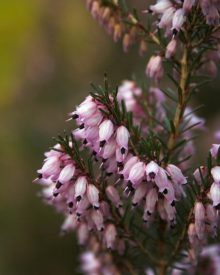 Heather is used for magick involving maturity, consummation, general luck, love, ritual power, conjuring ghosts, healing, protection, rain-making and water magick. Charms made with Heather can be worn or carried as protection against danger, rape and other violent crimes.
Heather is used for magick involving maturity, consummation, general luck, love, ritual power, conjuring ghosts, healing, protection, rain-making and water magick. Charms made with Heather can be worn or carried as protection against danger, rape and other violent crimes.
This flower represents good fortune and Heather can also be carried as a lucky charm. It was believed that wearing the blossom associated with your month of birth would bring exceptionally good luck – therefore people born in the month of Heather (August) should carry White Heather, for even better luck throughout the year.
Legend has it that a gift of white Heather brings luck to both the giver and the receiver, whereas red Heather is said to have been colored by heathens killed in battle by Christians, so is less lucky.
Heather is associated with secrets from the Otherworld. A sprig of white Heather placed in a special place of silence and meditation has the power to conjure ghosts, haints or spirits.
After picking a piece of white Heather at midnight, place it in a glass of river water in the darkest corner of your home. Sit and think of a departed loved one and it is said that the loved ones shadow will visit you.
Heather is said to ignite faery passions and open portals between their world and our own. Heather represents solitude because it thrives in wide open spaces, and Faeries who enjoy living in such undisturbed places are said to feast on the tender stalks of Heather. The Fae of this flower are drawn to humans who are shy.
Heather is useful for Solitary healing work (going within). Heather, if used along with Mistletoe, creates powerful healing medicine in both spiritual and physical aspects.
Heather can be used at Midsummer to promote love – carry red Heather for passion or white Heather for cooling the passion of unwanted suitors. If you give someone a gift of Heather it means: ‘Admiration’. A charm bag filled with Heather can be carried for decreasing egotism or self-involvement.
As a water herb, Heather is very useful in weather magick. When burned outdoors with Fern, the herbal smoke of Heather attracts rain. Bouquets of Heather and Fern can also be dipped in water to call rain.
Recommended Reading:
- Year of Moons, Season of Trees
- Tree Medicine Tree Magic
- A Druid’s Herbal
- Celtic Astrology
- Glamoury: Magic of the Celtic Green World
- The Book of Druidry
Source: dutchie.org
Purpose: Re-dedication to the Lord and Lady, beginning of the harvest, honoring the Sun God, honoring the pregnant Goddess
Dynamics/Meaning: Crowning of the Sun God, death of the Oak King, assumption of the Holly King, end the ordeal of the Green Man
Tools, Symbols and Decorations: The sun, oak, birch & fir branches, sun flowers, lilies, red/maize/yellow or gold flower, love amulets, seashells, summer fruits and flowers, feather/flower door wreath, sun wheel, fire, circles of stone, sun dials and swords/blades, bird feathers, Witches’ ladder.
Colors: Blue, green, gold, yellow and red.
Foods: Honey, fresh vegetables, lemons, oranges, summer fruits, summer squash, pumpernickel bread, ale, carrot drinks, mead.
Goddesses: Mother Earth, Mother Nature, Venus, Aphrodite, Yemaya, Astarte, Freya, Hathor, Ishtar, all Goddesses of love, passion, beauty and the Sea, and Pregnant, lusty Goddesses, Green Forest Mother; Great One of the Stars, Goddess of the Wells
Gods: Father Sun/Sky, Oak King, Holly King, Arthur, Gods at peak power and strength.
Animals/Mythical Beings: Wren, robin, horses, cattle, satyrs, faeries, firebird, dragon, thunderbird
Gemstones: Lapis lazuli, diamond, tiger’s eye, all green gemstones, especially emerald and jade
Herbs: Anise, mugwort, chamomile, rose, wild rose, oak blossoms, lily, cinquefoil, lavender, fennel, elder, mistletoe, hemp, thyme, larkspur, nettle, wisteria, vervain ( verbena), St. John’s wort, heartsease, rue, fern, wormwood, pine,heather, yarrow, oak and holly trees
Incense/Oil: Heliotrope, saffron, orange, frankincense and myrrh, wisteria, cinnamon, mint, rose, lemon, lavender, sandalwood, pine
Rituals/Magicks: Nature spirit/fey communion, planet healing, divination, love and protection magicks. The battle between Oak King, God of the waxing year and Holly King, God of the waning year (can be a ritual play), or act out scenes from the Bard’s (an incarnation of Merlin) “A Midsummer Night’s Dream”, re-dedication of faith, rites of inspiration.
Customs: Bonfires, processions, all night vigil, singing, feasting, celebrating with others, cutting divining rods, dowsing rods and wands, herb gathering, handfastings, weddings, Druidic gathering of mistletoe in oak groves, needfires, leaping between two fires, mistletoe (without berries, use as a protection amulet), women walking naked through gardens to ensure continued fertility, enjoying the seasonal fruits and vegetables, honor the Mother’s fullness, richness and abundance, put garlands of St. John’s Wort placed over doors/ windows and a sprig in the car for protection.
Found at: Two Pagans
Art by Rachael Rose Zoller
- Latin names: Lythrum salicaria
- Common names: Spiked loosestrife, Purple lythrum, Flowering Sally
- Gender: Feminine
- Planet: Moon
- Element: Earth
- Parts Used: Flower, leaf and stem, root
- Powers: Peace, protection
Magical Uses:
Placed in the corners of each room, this herb restores harmony and brings peace. Give to a friend to help settle an argument. Brings about protection and peaceful energies when placed in the home.
This plant was considered most powerful when gathered on the Summer Solstice. One could control demons and troublesome spirits with the root if the following words were chanted over it before a sacred image:
Tear-weed, tear-weed
You have wept long and much but gained little.
May your tears not drown the open field
Nor your cries sound over the deep blue sea.
Frighten off the demons and the witches!
If they do not submit to you,
then drown them in your tears!
If they run from your glance,
throw them over cliffs or into pits!
May my words be firm and strong
for hundreds of years!
Information collected from various sources





